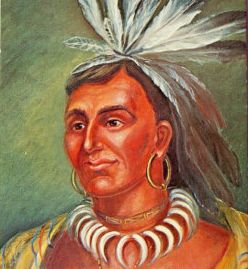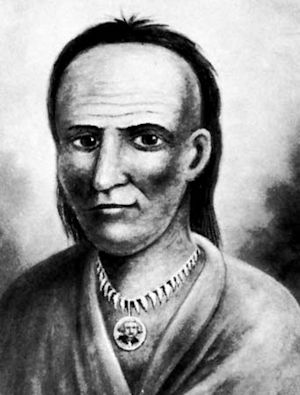Little Turtle was a Miami chief, who fought several battles with the United States in the 1790s, which was referred to at the time as Little Turtle’s War (now known as the Northwest Indian War). In 1791, his warriors defeated General St. Clair, who lost 623 men, the most decisive loss by the US against Native American forces ever.
 Indian Name: The name ‘Little Turtle’ is an English translation of his name in the Miami-Illinois language, mihšihkinaahkwa. In his language, the word names a species of terrapin, probably the Midland Painted Turtle.
Indian Name: The name ‘Little Turtle’ is an English translation of his name in the Miami-Illinois language, mihšihkinaahkwa. In his language, the word names a species of terrapin, probably the Midland Painted Turtle.
Alternate spellings: Michikinikwa, Meshekunnoghquoh, Michikinakoua, Michikiniqua, Me-She-Kin-No, Meshecunnaquan and Mischecanocquah
Little Turtle was born at his village on the Eel River in what is now Indiana. There is little documentary evidence for most of Little Turtle’s life, and the exact year and place of his birth are uncertain. He was born just before or just after the period that his parents lived in the Miami village of Pickawillany, known to be from 1747 to 1752. He was born in what is now Whitley County, Indiana, at either a small Miami village by Devil’s Lake, or at a larger nearby village known as Turtletown.
His father was a Miami chief and his mother a Mahican. According to the Miami social structure, decent is recorded from the matriarchial line, so he was considered a Mahican and thus received no advantage from his father’s rank. This meant he could not be a chief by hereditary descent. Although he became the war chief of the leading division of the tribe, Little Turtle was never the head chief of the Miami, which was a hereditary position.
Little Turtle emerged as a war chief of the Atchatchakangouen division of the Miami tribe while a comparatively young man. He earned this distinction by defeating the French military adventurer Augustin de La Balme. In October 1780, La Balme plundered the principal Miami village of Kekionga (present-day Fort Wayne), as part of his campaign to attack the British in Detroit.
On 5 November 1780, Little Turtle led an attack on La Balme’s camp along the Eel River, killing La Balme and 30 of his men and bringing an end to that campaign. The victory established Little Turtle’s reputation as a war leader, and through the 1780s, he led raids against colonial American settlements in Kentucky, fighting on the side of the British.
Little Turtle was one of the principal leaders of the Indian forces that defeated General Harmar on the Miami River in October 1790.
His army then defeated General St Clair at St. Marys, November 4, 1791, killing an estimated 600 US soldiers, the biggest defeat of the US in all the Indian Wars, before and after.
Little Turtle and Bluejacket were the main leaders of the Indians in the Miami conflict with General Wayne’s army in 1795, although he had urged the Indians to make peace with this “chief who never sleeps.”
After their defeat by the whites in this last battle, he joined in signing the treaty at Greenville, Ohio, on August 3, 1795, remarking, as he signed it, ” I am the last to sign it, and I will be the last to break it.” Faithful to this promise he remained passive and counseled peace on the part of his people until his death at Ft Wayne, July 14, 1812.
Early in 1797, accompanied by Captain Wells, who was his brother-in-law, he visited President Washington at Philadelphia, who gave him a fancy ceremonial sword. This is also where he met Count Volney and General Kosciusko, the latter presenting him with a pair of elegantly mounted pistols.
He also met presidents John Adams and Thomas Jefferson. He and Jefferson discussed the need to introduce American agriculture to Miami society, although it was the Quaker society of Baltimore who finally sent Philip Dennis to demonstrate East Coast farming methods some years later.
Although Tecumseh endeavored to draw him away from his peaceful relations with the whites, his efforts were in vain. Little Turtle promoted peace with the whites for the rest of his life.
Little Turtle’s War
 In the Treaty of Paris (1783) which ended the American Revolutionary War, the British abandoned their native allies and ceded the land between the Appalachian Mountains and the Mississippi River to the United States. The Americans considered the region to be theirs by right of conquest.
In the Treaty of Paris (1783) which ended the American Revolutionary War, the British abandoned their native allies and ceded the land between the Appalachian Mountains and the Mississippi River to the United States. The Americans considered the region to be theirs by right of conquest.
Through the creation of the Northwest Territory in 1787, they began to divide the land north of the Ohio River for settlement. Native Americans living in the territory resisted and violence escalated; Native Americans formed the Western Confederacy with the goal of keeping the Ohio River as a boundary between Indian lands and the United States.
Little Turtle emerged as one of the leaders of this confederacy, which included the Shawnee under Blue Jacket and the Delaware under Buckongahelas. The war which followed has become known by historians as the Northwest Indian War, but it was once known as “Little Turtle’s War.”
In 1790, the United States sent an expedition under the command of General Josiah Harmar to end the border war. Because the United States had mostly disbanded its military after the Revolution, it had few professional soldiers to send into battle, a weakness which Little Turtle and other native leaders fully exploited.
In October 1790, Little Turtle and Blue Jacket won two victories against Harmar’s men. These successes encouraged previously reluctant leaders among the Ottawa and Wyandot to join the confederacy.
In 1791, Little Turtle and Blue Jacket led 1,000 warriors and defeated another American expedition, this time led by General Arthur St. Clair. It was the worst defeat the Americans would ever suffer at the hands of American Indians, 623 soldiers were killed and another 258 wounded. According to the most popular version of the story, Little Turtle was in overall command of the army that defeated St. Clair, although other accounts suggest that Blue Jacket was the preeminent native leader.
General Anthony Wayne commanded a third expedition in the Northwest, His U.S. troops were of superior numbers and had just completed rigorous training. After an exploratory attack on Fort Recovery in June 1794, Little Turtle counseled negotiation rather than battle, remarking that Wayne “never sleeps.” According to a widely circulated story, he ceded command to Blue Jacket, although retaining leadership of the Miami tribesmen. Little Turtle’s son-in-law, William Wells, switched sides and served as a scout for the Legion of the United States.
The confederacy, numbering around 1,000 men, was defeated at the Battle of Fallen Timbers. This battle forced the confederacy to sign the Treaty of Greenville.
In 1809, Little Turtle suffered a break with other Miami leaders when Governor William Henry Harrison came to Fort Wayne to renegotiate treaty terms. Little Turtle admitted Potawatomi representatives to the treaty and cooperated with Harrison, but other chiefs, including his brother Pacanne and his nephew Jean Baptiste Richardville, Owl, and Metocina refused to sell any more land. Harrison was forced to recognize the Mississinewa chiefs as the true representatives of the Miami, and to declare that Little Turtle was not a Miami.
Little Turtle’s Indian name as signed to different treaties varies as follows:
- Greenville, August 3, 1795 Meshekunnoghquoh
- Ft Wayne, June 7, 1803, Meseekunnoghquoh
- Vincennes, August 21, 1805, Mashekakahquoh
- Ft Wayne, September 30, 1809, Meshekenoghqua
Little Turtle’s Burial
Little Turtle retired to a spot near present-day Columbia City, Indiana. After the Siege of Fort Wayne in the War of 1812, General William Henry Harrison ordered the destruction of all Miami villages within a two-day march of Fort Wayne. This may have been in retaliation for the negotiations in 1809, but his forces also destroyed the village of Little Turtle.
Little Turtle died in 1812, at the home of his son-in-law William Wells (soldier), not far from Kekionga. He had been suffering from gout and rheumatism for some time. He was honored with a military-style funeral at Fort Wayne. He was buried in his ancestral burial ground near Spy Run.
In 1912 his grave was accidentally disturbed during a construction excavation. The sword and other artifacts buried with him were placed with the Allen County-Fort Wayne Historical Society, and his remains were reinterred.
A small memorial stone was placed there, which reads:
“This site honors the great Chief of the Miamis, Meshekinoqua, “The Little Turtle,” son of the great Chief Acquenacque. He is held in the hearts of his people, allies, and foes with the greatest of honor and respect for his courageous valor and peacemaking.”
In 1959, the site was purchased by the Smeltzly sisters of Fort Wayne, to hold up Little Turtle’s peacemaking efforts “as an example to future generations.” They donated the land to the city as a public park “dedicated to the children of America.” In 1994, the memorial was improved with additional markers and a trust established for its maintenance.